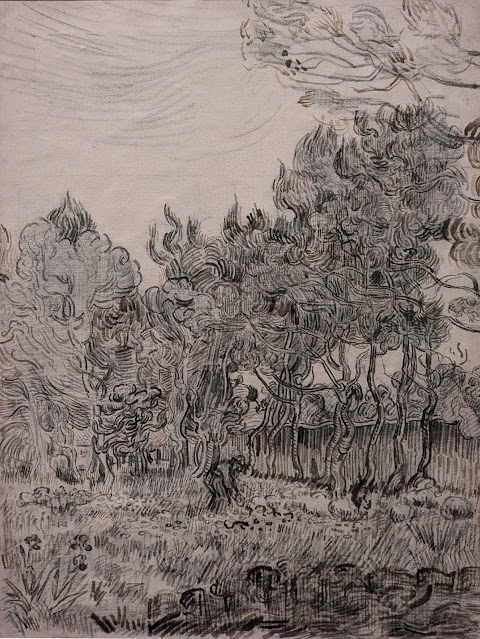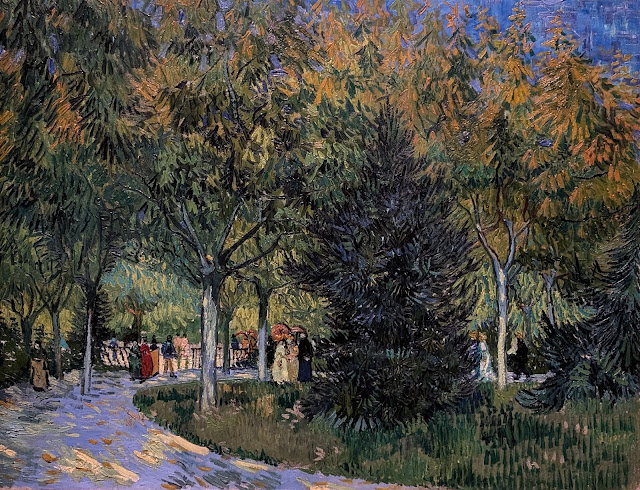Note: This write-up of London’s National Gallery’s major exhibition: “Van Gogh: Poets and Lovers” will be over 3 parts.
This show is a once-a-century blockbuster.
It contains 60 (!!!) of Van Gogh’s most famous pictures. There have been loans from around the world — from Athens to Mexico City! And, some, very special paintings from private collections (which we may never see again).
Everything in the exhibition was painted in the 2 short years that he spent in the South of France, in both Arles and Saint-Rémy-de-Provence. It attempts to challenge our misconceptions of Van Gogh. By curating the show thematically (i.e. “garden” or “decoration”), his works can be seen in a fresher perspective. The gallery doesn’t want us to fall into the trap of seeing Van Gogh in the cliche chart of: ... Hope on arrival to set up an artists colony... Disintegrating relationship with Gauguin... Severing off ear... Going mad... Lunatic asylum... Suicide...
Instead, themes pervade the entire gamut of Van Gogh’s time in the South of France — both Arles and Saint-Rémy. As such, he was interested in the recurring ideas & themes ... a consistency.
My overall thoughts:
- Amazing capacity as a colourist, and the way he arranges compositions.
- Love the incredible atmospheric scenes rendered & their “life-force” (part 2).
- The expressive brushstrokes in his use of colour in portraitures — not descriptive, but quite expressive and symbolic.
✲✲✲
Room 1 — Introduction (1888)
In Feb 1888, Van Gogh went to live and work in the South of France.
This room instances van Gogh’s enduring love for parks and nature, and his symbolic portraits of “The Poet” and “The Lover” (betokening the exhibition’s title).
The Lover, Portrait of Lieutenant Milliet - 1888
A stately & striking picture. This is “The Lover” ...
It seems Milliet was known to Van Gogh as the epitome of success — a military man and “conquering” with the women.
Van Gogh depicts the Lieutenant in a dashing uniform, a distant serious aspect, a bold and elegantly bristling moustache, an overall dignified appearance.
The dark green background creates a dramatic surface to further highlight his aspect.
Beautiful.
✲✲✲
The Poet’s Garden (Public Garden in Arles) - 1888
Beautiful.
This scene was from a public garden in front of Van Gogh’s home in Arles.
He noticed young lovers would stand in the shade of a spreading fir tree. He imagined it as “the poet’s garden” — place frequented by artists and writers.
He used his artistic power to imagine and create an idealised world.
✲✲✲
The Poet, The Portrait of Eugène Boch - 1888
Love it.
This guy — Mr. Boch — was actually an artist. But, van Gogh thought he was the “ideal” poet.
Apparently, he thought his narrow face reminded him of the poet Dante.
The blue sky was intended to convey the impression of a man who “dreams great dreams.”
✲✲✲
Room 2 — The Garden: Poetic Interpretations
Van Gogh spent a lot of his artistic energy on the public gardens — both in Arles and the hospital of Saint-Paul de Mausole at Saint-Rémy.
This room explored van Gogh’s varied approach, viewpoints, use of colour in his desire to convey a emotional/poetic meaning, as opposed to accurate representation.
Entrance to the Public Garden in Arles
Charming.
I like how the surface of the pathway seems to resemble the beaten and trodden sandy paths that we can see in parks today.
The treetops and canopy are almost jungle-like. The variety of colours and brushstrokes create a summery feel. I also like the everyday nature of the people ... reading a newspaper, sitting on a park bench, ambling with shopping in hand ...
This may be the same public garden as “The Poet’s Garden” (above)? Certainly in Arles.
✲✲✲
The Public Garden, Arles, 1888
An intimate space.
The autumnal feel of this park scene is beautifully evocative. People sitting on park benches. The garden’s plants and verdure ...
I love the detail of golden leaves fallen onto the pathway.
✲✲✲
The Public Garden, Arles
Painted over the summer of 1888 in Arles.
He beautifully captures different shades of leaves across the canvas - sunshine? shades?
✲✲✲
Undergrowth
Wow!
Van Gogh became fascinated with a neglected garden at the Saint-Remy hospital.
The richly textured swirling blotches of paint evoke the ivy and dense undergrowth and dappled light.
✲✲✲
The Garden of the Asylum at Saint-Rémy
Oh my!
Incredible. So much bloom, fecundity and flowering ...
This was the 1st painting Van Gogh made when arriving at St-Remy as a patient. Which gives makes the painting a little sorrowful.
The centre of the painting is a romantic bench nestled inside a cloud of flowers and trees.
✲✲✲
Flowering Shrubs
 |
| Chalk, diluted oil paint and pencil on paper. |
Beautiful.
I’d never seen Van Gogh’s rapid application of bold chalk dashes and swirls.
According to the gallery, his works on paper belong to a unique & small group of diluted paint in which Van Gogh sought to capture the vibrancy of spring growth.
I love the little detail of a man walking through the gardens (in the back).
✲✲✲
Tree and Bushes in the Garden of the Asylum
 |
| Chalk, diluted oil paint and pencil on paper. |
Another wow. Even in “plain” chalk, it’s beautiful.
✲✲✲
The Park of the Hospital at Saint-Rémy
This is a melancholy painting and, I find, quite intense.
According to the NG: VG wrote a letter to Emile Bernard saying that he was struck by how the sawn-off tree resembled a “dark giant” — a person brought low.
It’s somber and grave — baren unadorned trees, bleak and gloomy grounds with no vegetation, setting sun ...
✲✲✲
Hospital at Saint-Rémy, 1889
Wow.
So enticing and beautiful.
I love the contrasts = reddish darkened soil (oppressive), golden-walled hospital, and aquamarine to lapis-lazuli skyline!
Such a full-bodied richness of colours.
Van Gogh deliberately rendered an imposing vertical format to the painting to capture the eminence of the hospital’s huge pine trees.
✲✲✲
Trees in the Garden of the Asylum
Spectacular view of Van Gogh’s hospital gardens.
A sensational display of colour among the foliage is matched by his iridescent skyline.
This was inspired by Japanese woodblock prints — which of course Van Gogh was greatly inspired by.
The tree trunks have that Japanese distorted & cropped effect.
✲✲✲
Roses
Very nice.
Delicate and charming.
✲✲✲
Irises
Irises grew in profusion in the South of France.
Van Gogh focuses on a single plant coming into full bloom.
The neighbouring vegetation being classic VG.
✲✲✲
Park at Arles with a Corner of the Yellow House
 |
| Quill & reed pen & brown ink over paper. |
VG drew this meandering path in Arles when he was renting there.
✲✲✲
The Weeping Tree
 |
| Reed pen and black ink on paper. |
An emotional tree with its rapid & rhythmic traces.
It has that strong and resonating force of spring.
































No comments:
Post a Comment